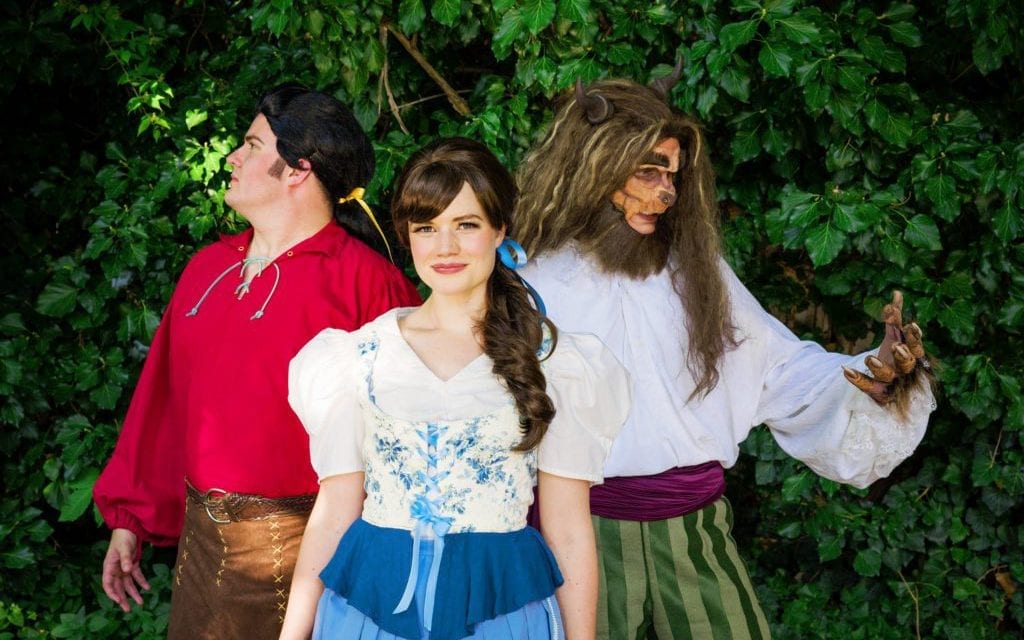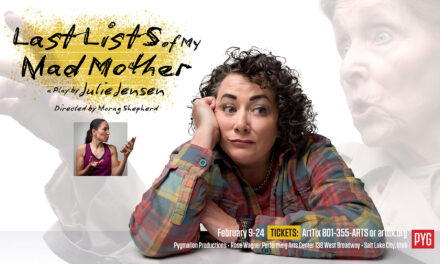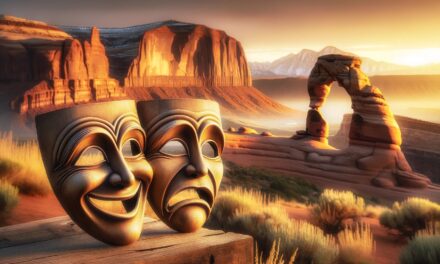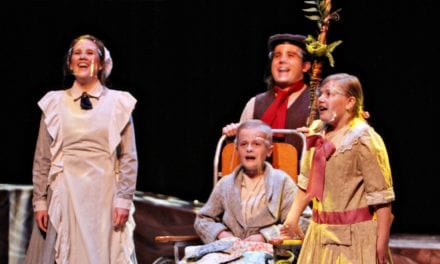OREM — SCERA has mounted an ambitious production of Disney’s Beauty and the Beast to end their summer season. While the production did not live up to the show’s full potential, it has enough strengths to make it a worthwhile evening for fans of the play.

Show closes August 17, 2019.
The best part of the production was the acting from the supporting cast playing the enchanted objects. As Lumiere, Samuel Wright stole the show, with his flawless French accent and personal magnetism that made him a believable womanizer. Wright’s initial scene showcased his acting talent, and I enjoyed watching Lumiere’s despair as he discussed turning into an object and his excitement at the possibility of the spell being broken. Thereafter, Wright never disappointed, and his performance of “Be Our Guest” had the dynamism of a circus ringmaster.

Lauren Pope as Belle. Photo by Rachel Gibson.
Kyle Baugh, as Cogsworth, was another memorable actor because of his ability to maximize the humor in every joke in Linda Woolverton‘s script. Cogsworth’s anxiety about telling Belle to come to dinner, or his resistance during “Be Our Guest” were highlights of the play. Brittney Wallace was an endearing Babette who could match Wright’s Lumiere in wit and charisma, even though her role was comparatively small. Finally, Janalee Hess’s performance as Mrs. Potts added a touch of class and gentleness to the castle scenes, and her rendition of “Beauty and the Beast” emphasized the song’s elegant simplicity.
Lauren Pope has a lovely singing voice that made “Something There” and “A Change in Me” some of the best moments in the second act. Pope’s strongest performances were when Belle’s forceful personality shined through, such as her resistance to the Beast’s demands that she eat with him, or during the reprise of “Belle.” In more subdued moments, though, Pope seemed aimless, especially in the first act when Belle asks her father about whether she is odd or when resisting Gaston’s advances during “Me.”

David Matthew Smith as the Beast. Photo by Rachael Gibson.
As the Beast, David Matthew Smith, was never imposing enough to inspire fear, and his movements rarely seemed animalistic. His voice sounded fully human, and I never detected anything beastly in his line deliveries. Smith also struggled to find the right pitch for many notes in “If I Can’t Love Her,” though his “How Long Must This Go On?” was better.
Overall, the acting performances were fine. But they could have been great, had the actors received better guidance from director Jerry Elison. For Beauty and the Beast, Elison seemed more concerned about blocking and staging and less concerned about the emotional core of the play. Many actions (such as Belle’s inexplicable willingness to linger and listen to Gaston’s advances during “Me,” or the staging of “No Matter What”) did not seem to emerge from the characters’ motivations and desires. Instead, it often felt like the person was moving because the director told them so. The mechanical blocking and shallow relationships inhibited the show and prevented it from exploring some of the play’s deeper themes.
Elison’s neglect of emotion extended to the ensemble scenes. I was saddened to see that the ensemble put little emotion behind Howard Ashman and Tim Rice‘s lyrics. “Human Again” lacked hope and longing, and “Gaston” was missing its exuberance. (It’s a drinking song. Pep it up!) The only ensemble song that resonated with emotion was the angry “Mob Song,” which showed the potential of the large cast.

Lauren Pope as Belle and David Matthew Smith as the Beast. Photo by Rachel Gibson.
Another missed opportunity was Dani LeCompte’s choreography, which consisted of little more than the most basic steps in musical theatre dance. This hobbled “Be Our Guest” and “Gaston,” though some acrobatics from Tanner Perkins did provide some spectacle in the movement. “Beauty and the Beast” was another subpar moment, mostly because of the dancing seemed wooden and poorly rehearsed.
On the other hand, I adored Shawn M. Mortensen‘s massive set, which not only delineated the space nicely, but had some surprises that strengthened “Be Our Guest” and the climactic fight scene. The set was painted to simulate the stone of the castle or the rustic homes of Belle’s town, and the result was a set that was a pleasure to look at for two and a half hours.
Another visual asset to this production was Kelsey Seaver‘s costume designs, which recalled the film versions of the story without mimicking them slavishly. The townspeople’s earth tones and maroons provided a unified palette that contrasted nicely with Belle’s blue dress in the opening scene. In the castle, the objects’ costumes were more intricate and luxurious, which showed the prosperity of the castle before the spell began. My only qualm with the costumes was in the famous ballroom scene, when Belle’s gown was a unsightly mustard color with uneven scallops along the skirt.
Despite the flaws in SCERA’s Beauty and the Beast, it is still a production worth seeing. The script and Alan Menken‘s score are as exquisite as they were 25 years ago when the stage version premiered on Broadway. In the SCERA’s production, the strengths in the design and acting outweigh the show’s weaknesses. There are just too many endearing actors and visual successes to dismiss the production out of hand. I believe SCERA’s Beauty and the Beast works best as a family outing to end any fun-filled summer, but the show is also an excellent date night or evening getaway.

This review was supported by a generous grant from the Orem CARE program.





